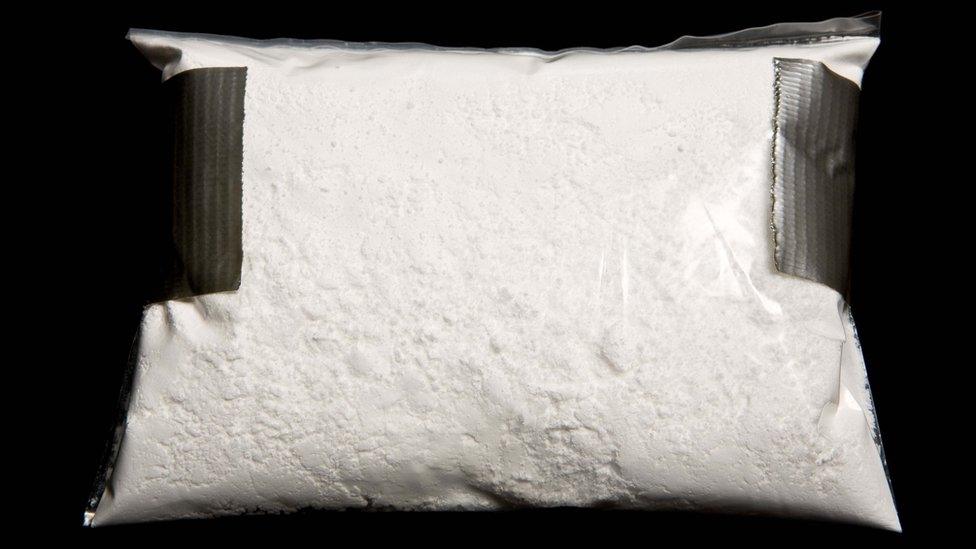Do six people die for every kilo of cocaine?
- Published

The Netflix drama, Narcos, about the infamous Colombian drug trafficker Pablo Escobar, cites a shocking statistic on the human cost of the drugs trade. But is it true?
Agent Steve Murphy is in an airport toilet when he sees two Americans snorting cocaine. He asks them if they know the true price of the drugs they are taking - more specifically, how many people die for every kilo of cocaine?
"Six lives - that's how much it cost," he tells them. "What do you think about that?"
It's a scene from Narcos, a Netflix drama series based on the real-life story of Murphy, an agent with the US Drug Enforcement Agency (DEA), who was sent to Colombia to track down and arrest Escobar.

Pablo Escobar headed the Medellin cartel, said to be behind 80% of all cocaine smuggled to the US
That scene was set in 1992. But was it really true at the time that six people lost their lives for every kilo of cocaine processed, shipped and distributed in the US?
The Netflix programme-makers told the BBC the statistic came from a DEA source who couldn't be named.
But fortunately Elizabeth Zilli, who was the DEA's head of intelligence in Colombia at the time, agreed to be interviewed.
"I really couldn't give you a number, but it was extremely high," she says. "We never totally trusted the statistics we were getting from the [Colombian] government. One never does, no matter where you are."
Corroborating the figures was difficult, she adds, because the DEA often relied on second- or third-hand information, and informants who may not have been totally reliable.

Large numbers of special police and army units were deployed in the hunt for Escobar
However, it's possible to very roughly approximate the cost in human life of a kilo of cocaine in 1992.
In 1992, Colombia had over 28,000 murders, while in the United States - a country with a population seven times bigger - there were around 25,000.
But there's a problem. We don't know which of these murders had anything to do with drugs. And coming up with a figure for drug-related homicide is virtually impossible, as Sanho Tree, a drug policy researcher at the Institute of Public Policy, explains.
"At various phases in the war between Pablo Escobar and the state, you know, they were blowing up airliners to go after particular people, that sort of thing," says Tree.
"How do you count all those bodies, and do you have enough witnesses to piece these pieces together? In Colombia, people don't talk because they know the moment they [make] an accusation, they are dead meat."

Cristina Umana played fictional drug lord, and Escobar rival, Judy Moncada in Narcos
So let's start with the highest possible figure and make an assumption we know is not true.
For the purpose of our sum, we will take it that every murder in the US and Colombia in 1992 was drug-related. That gives us a total of 53,000 deaths.
So now we just need the cocaine figures. Funnily enough, these are not easy to find either - you can hardly send a freedom of information request to a cocaine cartel.
"It was so difficult, especially with cocaine, to find out exactly what was being produced," says Zilli.

Find out more
More or Less is broadcast on BBC Radio 4 and the World Service
Download the More or Less podcast
More stories from More or Less

But the United Nations estimates 92 tonnes or 92,000 kilos of cocaine was produced in Colombia in 1992.
If there were six deaths per kilo, that would mean there would be something like half a million murders related to the drug trade. And given that we know the total number of murders in the US and Colombia was 53,000 in 1992, the six-deaths-per-kilo figure is clearly very wrong.
Furthermore, nine years later the official US intelligence-driven assessment of the production of pure cocaine in Colombia was 700 tonnes, according to David Murray, a senior fellow from the Centre for Substance Abuse Policy Research.
Multiplied at six deaths per kilo, says Murray, "4,200,000 people would have died in the production of those 700 tonnes in the single year of 2001 in Colombia. That would leave a body trail, and we simply don't see that either in Colombia even though there were periods of horrendous violence, and high homicide."

Colombian forces are still battling the drugs trade
If you want final proof that the six deaths per kilo figure is wrong, consider this. In 1992, if you included every murder committed on earth - which according to the best figures available was 437,000 - it still wouldn't give you enough for six murders per kilo of Colombian cocaine.
What isn't in doubt is that Pablo Escobar's time in Colombia was exceptionally bloody. The murder rate was around 80 per 100,000 people a year - compared with one per 100,000 in the UK in 2012 and five per 100,000 in the US. Escobar's eventual demise was a landmark moment in the US government's War on Drugs.
But Colombia's problems were about much more than just one man. The murder rate stayed very high in Colombia for another 10 years after Escobar's death.
Since then it has halved, but Colombia continues to have one of highest murder rates in the world and had more murders - 15,733 in 2012 - than the US, which had 14,827 the same year, even though America's population is still seven times larger.
Join the conversation - find us on Facebook, external, Instagram, external, Snapchat, external and Twitter , external